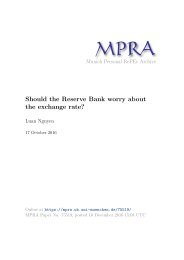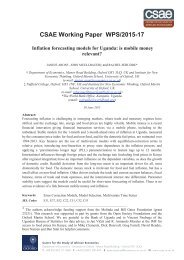debtequity
n?u=RePEc:red:sed016:1511&r=cba
n?u=RePEc:red:sed016:1511&r=cba
Create successful ePaper yourself
Turn your PDF publications into a flip-book with our unique Google optimized e-Paper software.
(18). Thus there exists R ∗ > E(ã) such that Φ(α ∗ ; R ∗ ) = E(ã) and the Central Bank policy<br />
(R B∗ , R D∗ ; α ∗ ) = (E(ã), R ∗ ; α ∗ ) leads to a Pareto optimal Flex equilibrium.<br />
Figure 4 gives a geometric interpretation of Proposition 6. It shows the same economy as in<br />
Figure 3(a) for which the banking equilibrium where banks pay the interest rate R B = E(ã) on<br />
their debt is such that R E > E(ã), and is thus not Pareto optimal. In the Flex equilibrium the<br />
Central Bank increases the interest rate charged to banks from E(ã) to R D∗ , shifting the banks’<br />
expected return curve downward so that it passes through the point (α ∗ , E(ã)), thereby achieving<br />
Pareto optimality.<br />
Figure 4: Pareto optimal Flex equilibrium.<br />
The equation which defines the rate R ∗ charged to banks<br />
E(ã) = 1 ∫ ∞<br />
α ∗ (a − (1 − α ∗ )R ∗ )f(a)da<br />
(1−α ∗ )R ∗<br />
can be written as<br />
∫ ∞<br />
(1 − α ∗ )R ∗ f(a)da =<br />
(1−α ∗ )R ∗<br />
∫ ∞<br />
(1−α ∗ )R ∗ af(a)da − α ∗ E(ã)<br />
= (1 − α ∗ )E(ã) −<br />
which is equivalent to<br />
∫ (1−α ∗ )R ∗<br />
a<br />
af(a)da<br />
∫ ∞<br />
R ∗ f(a)da + 1 ∫ (1−α ∗ )R ∗<br />
(1−α ∗ )R ∗ 1 − α ∗ af(a)da = E(ã) (22)<br />
a<br />
37





